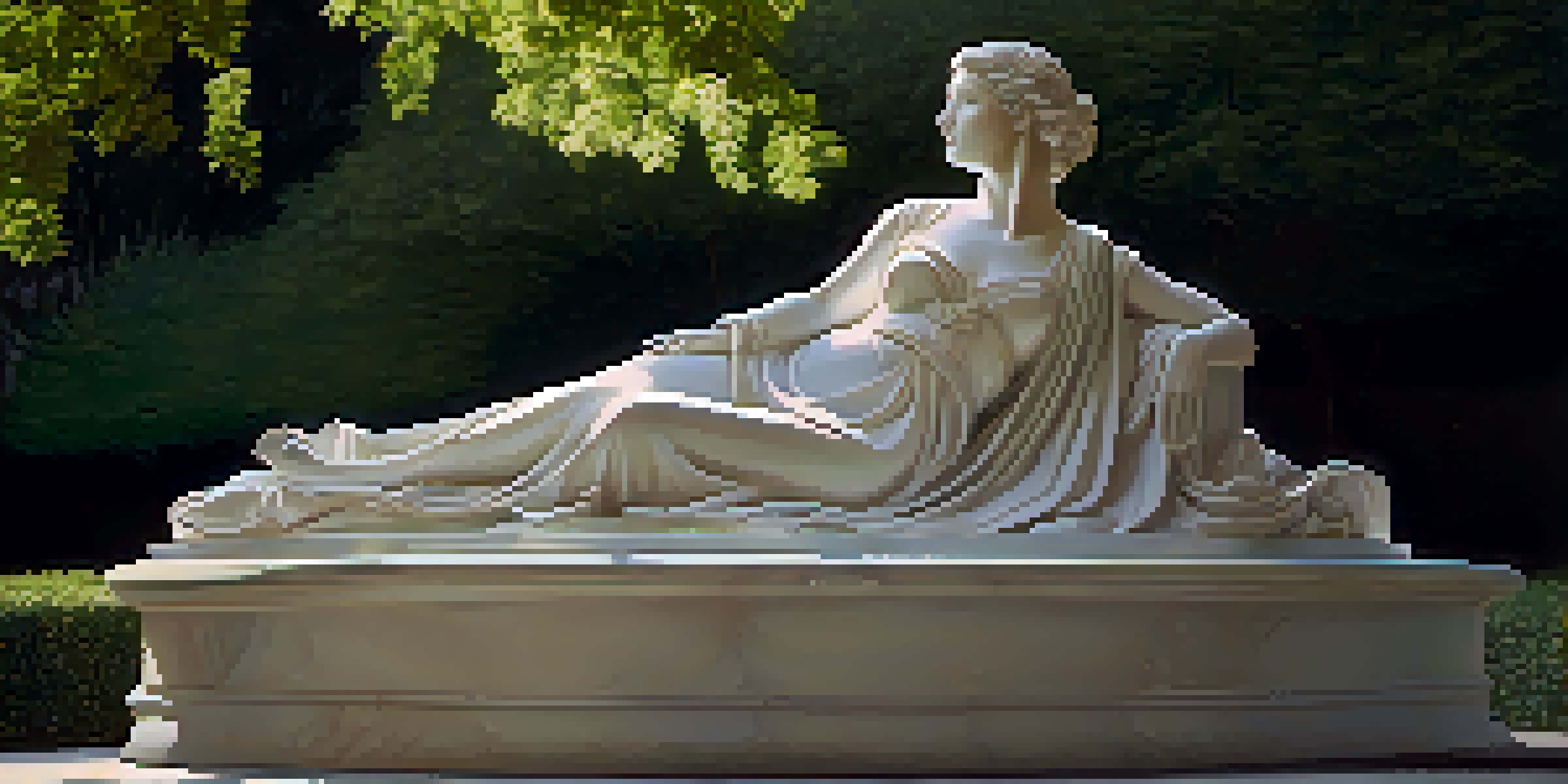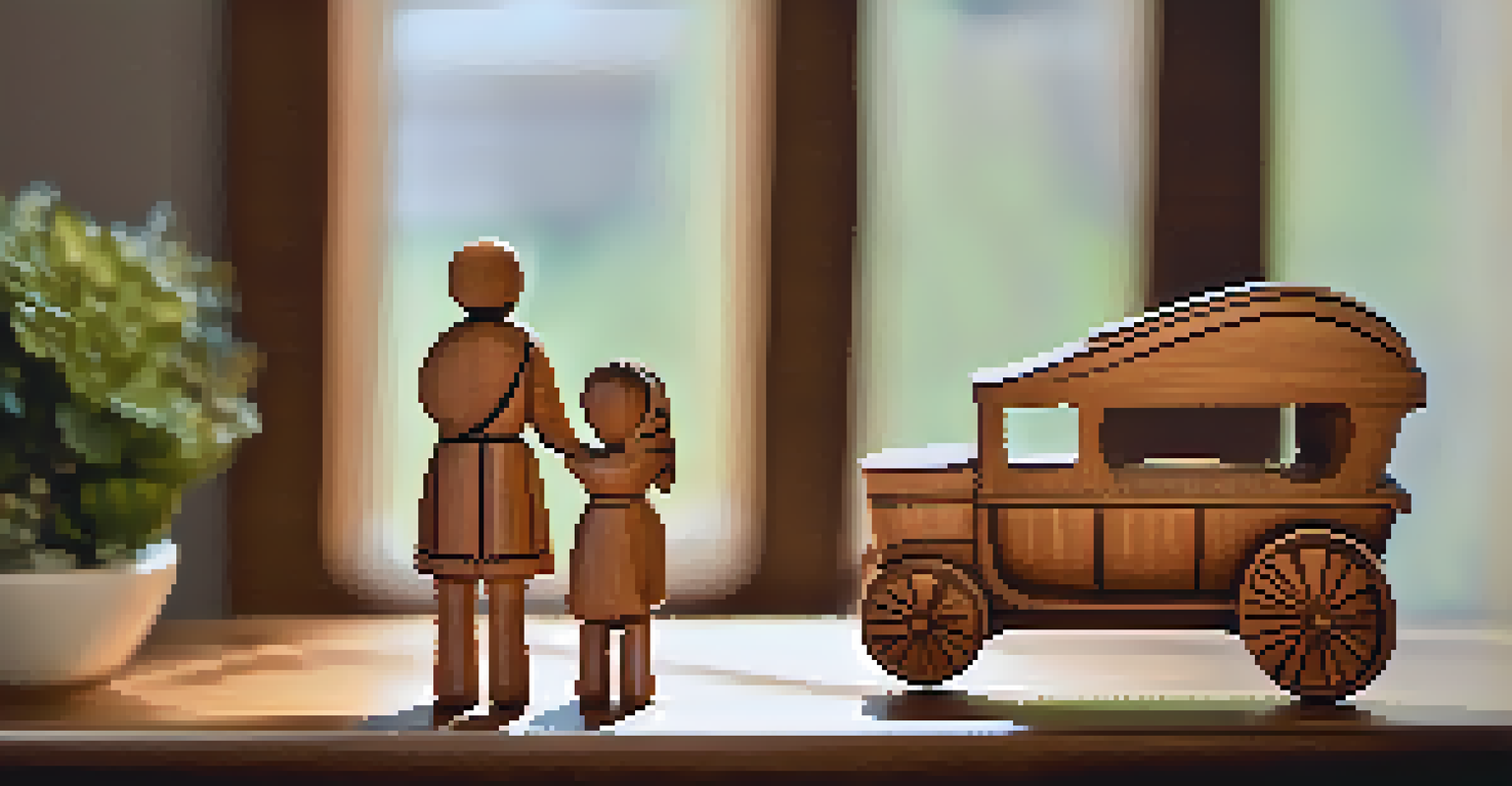The Emotional Impact of Sculpture Compared to Carving Techniques

Understanding the Emotional Power of Sculpture
Sculpture, as a three-dimensional art form, has a unique ability to evoke emotions. The tactile nature of sculpture invites viewers to engage with it on a deeper level, allowing for a personal connection. For example, a life-sized statue can evoke feelings of awe or reverence, drawing us into the artist's intention.
Sculpture is the art of the intelligence.
The materials used in sculpture, whether it's marble, bronze, or clay, also play a significant role in emotional resonance. Each material carries its own weight and texture, influencing how we perceive and feel about the piece. A smooth, polished surface might elicit a sense of serenity, while a rough, unrefined texture could invoke feelings of chaos or turmoil.
Ultimately, the emotional impact of sculpture is multifaceted, shaped by both the artist's intent and the viewer's personal experiences. This connection is often immediate and visceral, making sculpture a powerful medium for storytelling and expression.
The Role of Carving Techniques in Sculpture
Carving techniques are fundamental to the creation of many sculptures, impacting both form and emotional expression. Techniques like direct carving allow artists to work intuitively, responding directly to the material's properties. This spontaneous interaction can lead to unexpected emotional depth in the final piece.

Different carving techniques, such as relief carving or in-the-round, also influence how viewers engage with the sculpture. Relief carving provides a more narrative-focused experience, inviting viewers to explore the story depicted within the shallow depth, while in-the-round sculptures encourage a 360-degree exploration, creating a dynamic emotional response.
Sculpture Evokes Deep Emotions
The tactile nature of sculpture fosters personal connections, allowing viewers to engage with the artist's intent on a profound emotional level.
Moreover, the precision and skill involved in carving can reflect the artist's emotional state during the creation process. For instance, meticulous detail might convey a sense of care and devotion, while rough, aggressive carving can express frustration or raw energy, adding layers to the emotional understanding of the work.
Comparing Emotional Responses to Different Materials
The choice of material in sculpture profoundly affects the emotional response it elicits. For instance, a soft material like clay can evoke feelings of warmth and approachability, while a hard material like granite might inspire admiration or intimidation. This difference illustrates how material selection can frame the viewer's emotional journey.
Art is not freedom from discipline, but disciplined freedom.
Consider a bronze sculpture: its metallic sheen and durability often convey strength and permanence, making it suitable for memorials or public art. On the other hand, a wooden sculpture can evoke feelings of nostalgia and organic beauty, connecting viewers to nature. Each material tells its own story, shaping our emotional experience.
Ultimately, understanding these material nuances allows both artists and viewers to appreciate the emotional depth of sculptures more fully. By recognizing how different materials influence feelings, we can cultivate a richer engagement with the art.
The Importance of Context in Emotional Interpretation
The context in which a sculpture is displayed can significantly alter its emotional impact. For example, a statue placed in a bustling urban environment may evoke feelings of isolation or contemplation, while the same piece in a serene park might inspire tranquility or connection with nature. Context shapes how we perceive and interact with art.
Moreover, cultural and historical contexts provide additional layers of meaning. A sculpture representing a significant historical figure can invoke feelings of pride or reflection on past struggles, depending on cultural associations. Understanding these layers enhances our emotional engagement with the piece.
Material Choice Influences Feelings
Different materials in sculpture, like bronze or clay, shape the viewer's emotional experience and frame their connection to the artwork.
By considering context, both artists and viewers can deepen their understanding of the emotional narratives within sculptures. This awareness fosters a more profound appreciation of how a sculpture resonates within its environment.
The Impact of Scale on Emotional Experience
The scale of a sculpture can dramatically influence its emotional impact. A monumental sculpture can instill feelings of awe and grandeur, often overwhelming the viewer with its size and presence. For instance, the towering statues of Easter Island command respect and curiosity, drawing viewers into their mysterious narrative.
In contrast, smaller sculptures can create an intimate emotional connection, inviting viewers to lean in and engage closely. A petite, intricately carved figurine may evoke feelings of nostalgia, prompting personal reflections or memories. The physical size alters how we emotionally relate to the piece.
Thus, scale is not merely a technical aspect of sculpture; it is a crucial component of emotional engagement. Artists can manipulate scale to guide viewer responses, shaping the emotional landscape of their work.
The Artist's Emotional Journey in Sculpture Creation
Creating a sculpture is often a deeply emotional journey for the artist, one that significantly impacts the final piece. As artists carve, mold, or shape their materials, they channel their feelings and experiences into their work. This emotional investment can create a palpable energy that resonates with viewers.
For instance, an artist who is experiencing joy may create vibrant, uplifting forms, while one grappling with sorrow may produce darker, more somber pieces. This emotional interplay can make the artwork feel alive, inviting viewers to connect with the artist's internal world.
Context Shapes Emotional Interpretation
The environment and cultural background in which a sculpture is displayed can significantly alter its emotional impact and meaning.
By understanding the artist's emotional journey, we can appreciate the layers of meaning embedded in their sculptures. This connection enhances our viewing experience, allowing us to engage with the art on a more personal level.
The Viewer’s Emotional Journey with Sculpture
The emotional journey of the viewer is a pivotal aspect of experiencing sculpture. As we approach a sculpture, our initial impressions can evoke a range of feelings, from curiosity to nostalgia. Each viewer brings their own experiences and emotions, creating a unique connection with the artwork.
For example, a sculpture depicting a familial scene might resonate deeply with someone reflecting on their own family memories, eliciting feelings of warmth or longing. This personal connection is what makes sculpture such a powerful form of expression; it speaks to our shared humanity.

Ultimately, the emotional journey of the viewer is ongoing, shaped by context, personal experiences, and the artist's intent. By embracing this journey, we foster a deeper appreciation for the emotional power of sculpture and its ability to connect us.